|
Handheld Algiz RT7
Elegant, expandable, ultra-rugged 7-inch Android tablet for work in demanding environments
(by Conrad H. Blickenstorfer; Photography by Carol Cotton)
Announced late 2015, Swedish Handheld Group's Android 5.1.1-based 7-inch Algiz RT7 tablet computer is the latest in the company's lineup of rugged mobile computers for field workers in all sorts of demanding environments. RuggedPCReview.com has now had a chance to examine this interesting compact tablet. This report describes the Algiz RT7 in detail, what it can do, and who it's for.
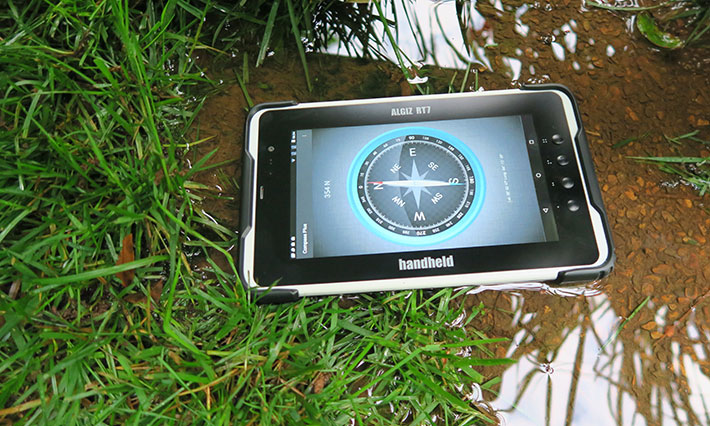 >
>
For a brief intro, the Handheld Group offers two primary product lines, those being the Nautiz branded rugged handhelds and the Algiz branded rugged tablets and notebooks. By now, most of the Nautiz handhelds are available with either Windows or Android, but on the Algiz side, the new Algiz RT7 represents Handheld's first Android-based product.
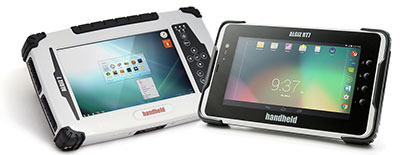 Let's answer some obvious questions first. For example, if most of the Nautiz rugged handhelds come with either Windows or Android and the Handheld Group already has a perfectly good 7-inch tablet in the Algiz 7 (the picture on the right shows the Windows-based Algiz 7 and the new Android-based Algiz RT7), why not simply offer that one with Android as well? Let's answer some obvious questions first. For example, if most of the Nautiz rugged handhelds come with either Windows or Android and the Handheld Group already has a perfectly good 7-inch tablet in the Algiz 7 (the picture on the right shows the Windows-based Algiz 7 and the new Android-based Algiz RT7), why not simply offer that one with Android as well?
Answer: that's because the processors in the Nautiz handhelds inherently support Android, whereas the CPUs used in the company's Algiz models do not. And why offer and support two operating systems? Answer: because unlike with consumer smartphones where Android and Apple's iOS totally dominate, in rugged tablets Windows is strong and Android is just now picking up steam. So supporting both platforms is important.
How to design an Android tablet for the field
There are other difficult questions. Enterprise customers have pretty much shown that they want their ruggedized tablets to look and feel just like consumer products. But how can you make a tablet that looks sleek and elegant and is tough enough for work out there in the field? Then there's the price. With generic tablets being practically given away and even some brand name tablets going for under US$100, what does that mean for rugged tablets that cost far more? And even that's not all. Fierce competition in the consumer tablet market has made expected specs and features a quickly moving target hard to match for any industrial and enterprise product designed for the longer haul.
So how can a company like the Handheld Group conceivably enter this commodity market with a product that by its very definition is not a commodity product, but enterprise and vertical market customers demand it must look and handle like one?
It's not easy, but the likely answer is to a) skillfully apply popular design concepts and features onto an underlying much more rugged platform, b) have a credible (if not incredible) spec sheet that gets the job done, and c) sell it at a price that convincingly confirms that its total cost of ownership is indeed lower than the consumer market if-it-breaks-just-get-another approach. Of course, having a stellar reputation for quality and service, and an attractive, cohesive product lineup and clear brand identity — both of which the Handheld Group has — doesn't hurt either.
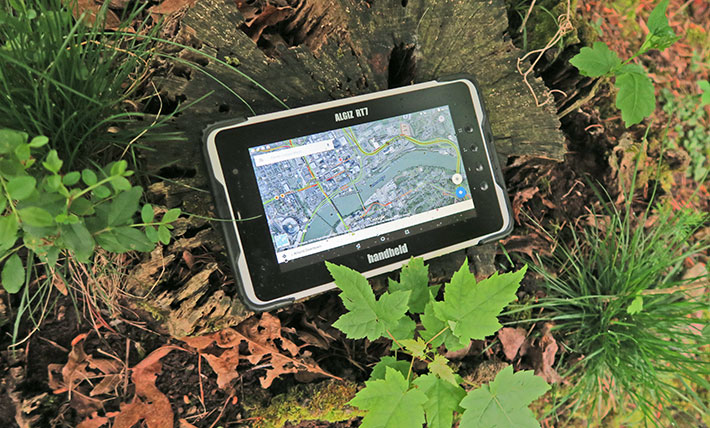
And that gets us to the Algiz RT7's specifics. It measures 8.5 x 5 inches. That's a bit more than a consumer 7-inch tablet, and makes it easier to hold and operate the tablet with gloves. Plus there are four programmable physical function buttons to quickly call up frequently used commands or apps, and the protective rubber bumpers. At 0.9 inches, the tough, sturdy Algiz RT7 is considerably thicker than a super-slender consumer tablet. And at about a pound and a half it weighs more, too (albeit less than the original iPad).
Likewise, while today's consumer tablets are ever more slender and lightweight, that also makes them fragile and lacking the space for industry standard ports and connectors. Here again, Handheld's customers may admire those sexy consumer tablets, but out there in the field their computing devices must hold up to whatever abuse they may encounter, and they must connect with standard cables and connectors. So that's what the Algiz RT7 is, a sensible tablet platform for the field.
Attractive hardware
Below you can see what the Algiz RT7 looks like from the front and from all four sides. It's an elegant design that, like all of the Handheld Group's devices, uses the company's signature gray and black color scheme and school of design. This consistent use of colors and design elements enabled the Swedish company to build a cohesive and instantly recognizable brand identity that we are certain contributed to their success. Whoever thought of that should get a big raise.
What looks like extensive rubber bumpers along each short side of the tablet and extending around the four corners is actually part of the housing, attached during an injection molding process. And note that all I/O ports are combined in a single block on the right side of the tablet. It can be sealed with a hinged plug that firmly fits into place (and is a bit of a fingernail buster to pry out).
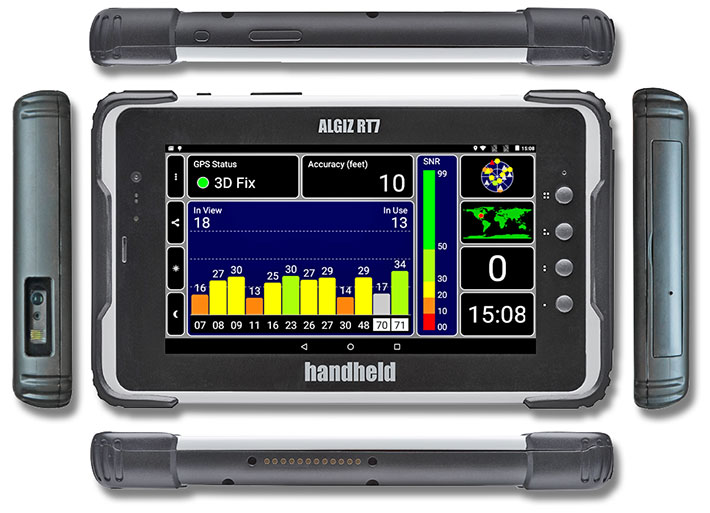
Below is a closer look at the right side of the unit that shows the I/O block with its protective plug opened. Available I/O includes a Type A standard-size USB 2.0 port, a Type B micro USB OTG (On The Go) port, a 10/100 RJ45 LAN jack, a 3.5mm audio port, and a DC charger jack.

The technology under the hood
It is more difficult to assess the technology and performance of an Android device than of a Windows device. When you look at all companies that offer both Android and Windows tablets, Windows tablets almost always have beefier specs. 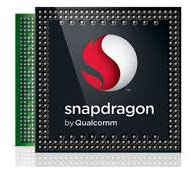 That's because Windows is a much larger and more resource-intensive OS and needs the extra hardware for perceived everyday performance parity. Handheld's Windows and Android 7-inch tablet stablemates follow that same pattern. That's because Windows is a much larger and more resource-intensive OS and needs the extra hardware for perceived everyday performance parity. Handheld's Windows and Android 7-inch tablet stablemates follow that same pattern.
Asked about this, Thomas Löfblad, Handheld's VP Global Sales, said "we built the Algiz RT7 to hit that perfect spot between value and efficiency. The less CPU-hungry Android OS allows high efficiency computing without consuming as much processing power. We evaluated other rugged Android tablets and chose a CPU that benchmarked higher than others we tested."
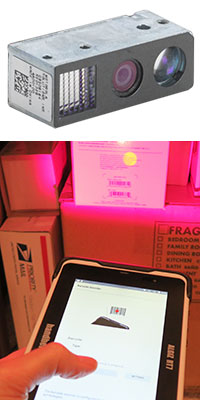 The 1.2 GHz Qualcomm MSM8916 "Snapdragon" chip in the Algiz RT7 is indeed a competent quad-core processor with an Andreno 306 GPU that supports all the features that matter in this class of tablet. It's used in numerous Samsung Galaxy, HTC Desire, Asus, Acer, Lenovo, Huawei and Motorola tablets and handhelds. The 1.2 GHz Qualcomm MSM8916 "Snapdragon" chip in the Algiz RT7 is indeed a competent quad-core processor with an Andreno 306 GPU that supports all the features that matter in this class of tablet. It's used in numerous Samsung Galaxy, HTC Desire, Asus, Acer, Lenovo, Huawei and Motorola tablets and handhelds.
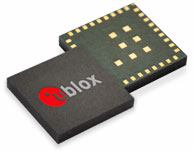 Onboard memory is just 16GB, but that can be expanded via an SDHC card slot. There's 2.5G (because it's still used in many parts of the world), 3G, as well as 4G LTE (which is state-of-the-art). And there are two SIM slots so both can be supported at the same time. Onboard memory is just 16GB, but that can be expanded via an SDHC card slot. There's 2.5G (because it's still used in many parts of the world), 3G, as well as 4G LTE (which is state-of-the-art). And there are two SIM slots so both can be supported at the same time.
There are two cameras, both entirely contemporary (2mp and 8mp AF). One for video conferencing and one for documentation. There are the requisite sensors a modern mobile computer must have, and an eTicket RFID reader is available as an option.
For navigation, there's a stand-alone integrated u-blox EVA-7M module that can handle GPS, GLONASS, QZSS and SBAS signals and reach 2-meter CEP accuracy. CEP stands for "circular error probable" and means that half of the time accuracy is within a radius of two meters from actual.
The Algiz RT7 can be used for bar code reading, too. And we're talking industrial-grade 1D/2D scanning via a Zebra SE4710 imager with red aiming LED and direct sunlight reading capability. That's in contrast to consumer smartphones and tablets which use the built-in camera and an app. That won't do for professional jobs. You do it with tech that was designed for fast, reliable scanning.
Construction and components of the Algiz RT7
One of our favorite tech sites in the world is fixit.com, the folks who built a business around taking computers apart, rating them according to how difficult it is to fix them, and they also sell all the special tools needed to disassemble tech gear without ruining it (we're customers). RuggedPCReview also takes gear apart, but we do it to examine whether a product is as tough and rugged inside as it is outside. And also to see how well it is sealed and how capable it is to perform under extreme conditions.
With that in mind, let's see how the Algiz RT7 is built. The backside of the Algiz RT7 is unadorned. There are no openings or access doors other than the battery compartment cover. That one is secured by no fewer than nine tiny Philips screws. Once you undo those and remove the cover you realize that the battery is actually part of the cover. It's a 3.7 Volt, 6,000 mAH Lithium-Ion design that provides 22.2 watt-hours.
Inside the battery compartment are not one but two SIM card slots as well as the tablet's microSD Card slot. These slots, of course, have direct access to the interior of the tablet, which means Handheld had to provide protection for the entire battery compartment, and not just around the actual power pins, as is often the case in such designs. They did this with a complex seal that sits in a groove around the interior perimeter of the battery. Which means that anytime the battery is replaced, careful inspection of that seal is required.
Below you can see the backside of the RT7 (left), the backside with the battery removed (right), and in-between the battery and a closer look at the three card slots.
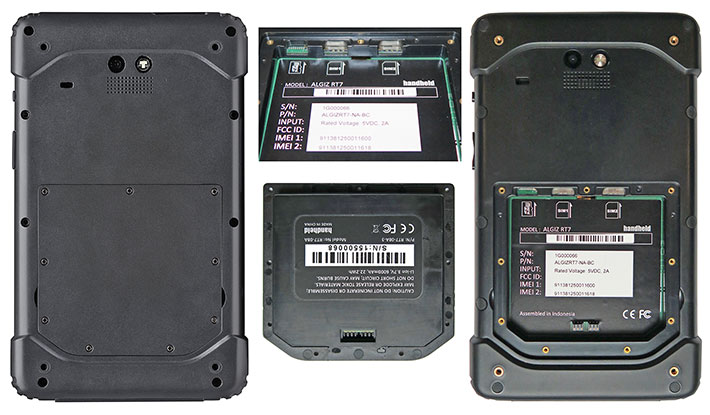
Further disassembly first requires removal of eight little rubber plugs that fill the holes of the screws that hold the two housing parts together. These are required to keep dirt from clogging the fairly deep screw holes when the device is used out there in the field, and germs from hiding if an RT7 were to be used in a clinical environment. The little plugs are not all of the same size and shapes, which makes keeping track of them a bit difficult, but they are certainly needed.
The nine small Philips screws that hold the halves of the RT7 together are easily undone. But that's the end of the easy part. That's because the two halves also employ some industrial-grade clips on each sort side to stay together, and getting those to let go requires a good degree of finesse, especially when flying blind, as is always the case when you take something apart for the first time. There's also a short ribbon cable between the two halves, and getting those reconnected can be a challenge. So we decided to leave the ribbon cable in place, and simply pull the two sides apart enough for a peek and a couple of pictures of inside.

What's revealed now is that the Algiz RT7 consist of a plastic upper and lower, with the upper part fortified by a thick, contoured metal plate, probably an aluminum or magnesium alloy. That metal backbone provides not only strength and rigidity, but also a very solid mounting surface for the display. In addition, the metal backbone is also part of the Algiz RT7's thermal management system. Equipped with a variety of heat-conducting pads that press against heat-generating electronic componentry, it serves as as a heat spreader and heatsink. It almost goes without saying that as an ARM-powered Android device, the RT7 does not need a fan.
Unlike the guts of most Wintel devices that always look a bit like the shrunken insides of a regular PC, the interior of the Algiz RT7 is more integrated and condensed. There are none of the readily recognizable modules and expansion cards that inhabit the interior of Windows-based devices. Instead, there's plenty of metal shielding and lots of transparent yellow plastic foil to keep things from touching and making contact.
Getting the RT7 back together is literally a snap. Align the two halves, press them together, and put the screws back in. Done.
An Android device
The Algiz RT7 comes with Android 5.1.1. Codenamed "Lollipop," Android 5.x introduced much improved device protection, improved Bluetooth and WiFi connectivity and also significantly improved security. All of this makes Android more attractive for enterprise and government customers, and will doubtlessly aid in the adoption of the Android platform in those markets.
 A few words here about the ongoing uncertainty of which operating system to go with. As of Spring 2016, we still have the weird situation where Microsoft Windows almost completely rules desktop and notebook computers (with only Apple as a serious general purpose alternative), Android almost completely rules smartphones (again, with only Apple as a serious (albeit mostly high-end) competitor). In tablets, it's all Android on the low end, and almost all Apple on the high end, though Microsoft's Surface tablets are making inroads. A few words here about the ongoing uncertainty of which operating system to go with. As of Spring 2016, we still have the weird situation where Microsoft Windows almost completely rules desktop and notebook computers (with only Apple as a serious general purpose alternative), Android almost completely rules smartphones (again, with only Apple as a serious (albeit mostly high-end) competitor). In tablets, it's all Android on the low end, and almost all Apple on the high end, though Microsoft's Surface tablets are making inroads.
It gets even stranger in the rugged mobile computing market, where Windows Mobile, later renamed Windows Embedded Handheld, continued to rule years beyond its shelf life simply because Microsoft did not provide a feasible upgrade or migration path. The uncertainty about what Microsoft might eventually do undoubtedly hurt the industrial handheld market. With Windows 10 that might finally change as it is based on a "unified core" for all Windows devices that is then complemented with various capabilities that depend on the type and class of device. That might mean Windows 10 IoT Mobile Enterprise for handhelds and standard Windows 10 for just about any other mobile device.
As is, there is still no clear direction in the rugged tablet market as far as operating systems go. Most major rugged tablet vendors offer both Windows and Android, often in the same or very similar hardware. As far as we're concerned, Android has a clear usability edge on smaller displays whereas Windows, of course, has an equally clear legacy systems and software edge.
In light of Android's massive popularity, it's obvious that Android-based rugged devices will have instant appeal and familiarity for those who already use Android smartphones and/or tablets at home or work. The basics of the Android interface are very widely known, and a massive number of apps are available for download. Android software development and expertise is readily available, and deploying Android devices on the job may save training as well.
Apps and software expertise galore
Our review Algiz RT7 came with a basic set of apps, but not with the "Handheld Market" we had seen on our earlier Handheld Nautiz X1 tester. The issue here, of course, is that easy access to online app stores may or may not be desirable for enterprise and vertical market devices. Customers may want to control that access by making available a special custom download channel, or impose other limits and controls. That's all easily possible with Android.
The test unit the Handheld Group sent us included full Google Play store access. So we're going to show a few sample screens that we captured via the Android SDK Monitor utility.
The first couple of pictures below show the Algiz RT7's default Home screen (left) and the Apps screen (right). Along the bottom of the display are the three Android default controls: back, home, and recent apps. They are implemented as soft buttons on the Algiz RT7.

Anyone who has ever used an Android device (over two billion by now) knows how tempting it is to populate them with a number of useful and/or interesting apps. Even a brief search will yield an almost unbelievable number of apps that can inexpensively add value to an Android device. Note, however, that "free" apps are not. They either include "in-app purchases" to unlock functionality, or they come with truly intrusive and often suspect advertising.
Anyway, a longtime favorite of ours is the colorful GPS Test utility that masterfully shows off how to present lots of data in an attractive, eye-catching display. And also that it's easy to add night viewing options to such software, such as the muted all-red setting shown on the right.

Google Maps was already installed on our evaluation RT7, and it's a natural for small tablets like the Algiz RT7 with its bright, responsive screen and integrated GPS.

There's eye candy galore for Android tablets. Apps such as the nicely designed compass on the left and the Route3D Yosemite three-dimensional topo map are two examples of all the innovative apps available.

Many people still wonder if it's possible to use Microsoft Office on an Android device, and the answer is an emphatic yes. Office Mobile apps can be downloaded from the Google Play store and used for free as long as the user has an Office 365 account with Microsoft. OneDrive users can then easily use on their Algiz RT7 whatever Word, Excel or Powerpoint documents they have in Microsoft's cloud.

Note that the Algiz RT7's four hardware function keys provide easy one-push access to frequently used functions or apps. Each key may perform a back or home command, or it can be used to launch any of the applications residing on the tablet without having to go to the app screen first.
What it all means is that the Algiz RT7 can be used as a standard Android tablet with standard Android apps and access to a vast amount of downloadable software, or it can be configured and used as an Android-powered mobile computer for dedicated and very specific tasks.
Display optimized for field use
While brochures and product specs usually highlight the type of processor, the amount of RAM and storage, expected battery life, ports and such, data about the display is usually limited to just diagonal size and perhaps resolution. That's a bit puzzling, as the display of a mobile computer is among its most important part. The quality and features of the screen have a direct impact on ease of use and satisfaction with a device. So let's go go into a bit more detail here than we normally would.
For basics, the Algiz RT7 has a display that measures 7.0 inches diagonally. It has 1,024 x 600 pixel resolution, which translates into 170 pixels per inch and a 17:10 wide-format aspect ratio. Its backlight is capable of generating 600 nits.
As far as the RT7's screen resolution goes, it's between the 800 x 600 (SVGA) or 1,024 x 768 (XGA) pixel resolution standards. That makes the 1,024 x 600 format either a wide version of SVGA or a short version of XGA. A few years ago, the format found use in tens of millions of "netbooks," the low-cost ultra-mobile small notebooks that were very popular before tablets took over. Most netbooks had screens in the 8-10 inch range and few customers complained about their resolution, so 1,024 x 600 on a smaller 7-inch screen is quite sharp.
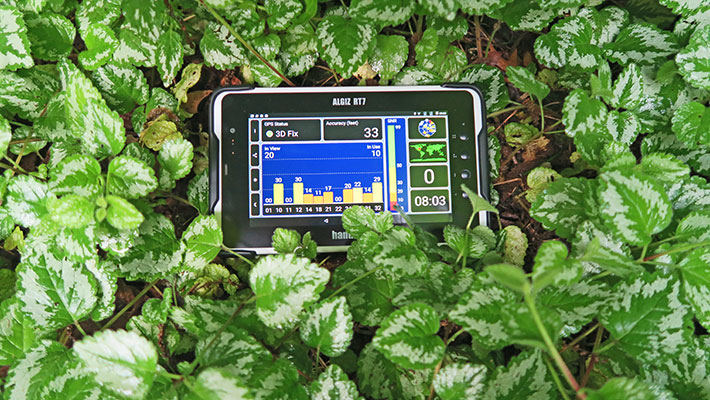
But don't many tablets and even laptops now have "retina" resolution, and some smartphones go even higher? Yes, but there's a law of diminishing return. As is, the 170 dots per inch of the Algiz 7 display is more than the original iPhone, iPad, and iPad mini, and also much more than any of the pre-retina MacBooks. Yes, you can still see individual pixels if you look very closely, but the display is more than sharp enough for the job.
What exactly does "nits" mean? It's gets pretty involved here, but for better or worse, nits is used to describe the brightness of a display. Technically it's not brightness but luminance that nits indicates. Luminance is measured in candela per square meter, where candela refers to luminous intensity, the power emitted by a light source. Since "candela per square meter" is a bit cumbersome, the industry uses "nits" which really is just short for "units". Laptop displays are usually in the 200 nit range, modern smartphones and tablets have 300-450 nits. Displays that need to be sunlight-viewable range from 500 all the way up to 1,500 nits. The Algiz RT7 screen is rated at 600 nits, i.e. it's rather bright.
But sharpness and brightness alone aren't everything. Viewing angle also matters very much in tablets. That means being able to look at the screen from any angle without the image looking any different. Here, the Algiz RT7 screen excels in horizontal viewing angle variation, but less so when varying the vertical viewing angle where there can be color and contrast shifts. I say "can" be because it very much depends on the colors. In some apps it's hardly noticeable, in others more so.
There are also two other characteristics of the Algiz RT7 screen. One is that it's almost matte, compared to the super-gloss that's present on virtually every consumer laptop, tablet and smartphone today. Another is that its type of LCD displays a degree of glittering when slightly moving the screen while looking at it. It's as if there were a coating of diamond dust.
What does all of this amount to in use of the Algiz RT7? Well, below are a few comparison pictures with a Dell Venue 8 7000 Series tablet. The Dell sports an incredibly sharp 360ppi OLED display that's rated at about 300 nits.
The first comparison picture shows the difference between the typical super-glossy display and the semi-matte Algiz7 screen. Glossy displays are almost mirror-like with sharp reflections that can make it difficult for the brain to tune out the distraction and just see what's on the screen instead. A semi-matte display mutes reflections considerably. That makes them much softer and easer for the brain to ignore and concentrate on the display instead.

In the second picture below, the computers are placed in shaded area on a Tennessee early afternoon, facing away from the sun. Here, the primary difference is in the hues of the displays, with the RT7 tending towards yellowish and the Dell tablet towards magenta.

In the third picture below, we changed the camera angle to introduce some background reflection. Those are hardly visible on the semi-matte RT7 screen, but very much so on the glossy Venue tablet. Effectively muting reflections is very important in a device designed to be used outdoors, and the RT7 does a great job at that.

Placed on the ground and facing the sky in broad daylight, the RT7 is somewhat brighter, though both tablets demonstrate how far outdoor-viewable display technology has come via filters, polarizers, direct bonding, etc.
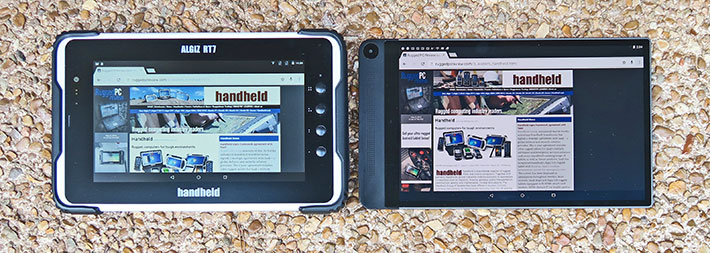
The next picture shows one characteristic of a matte display: while it virtually eliminates sharp reflections, the diffusing effect of the matte screen can render the screen milky.
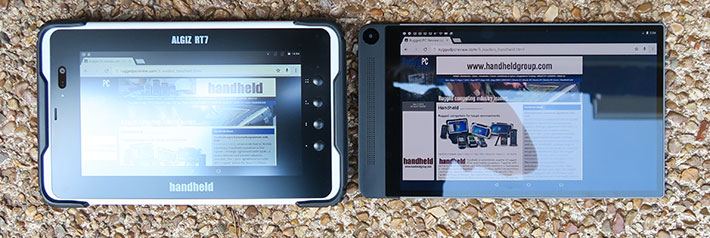
Finally, an indoor comparison again shows the brightness advantage the Algiz RT7 has even over very good consumer/enterprise tablet displays.
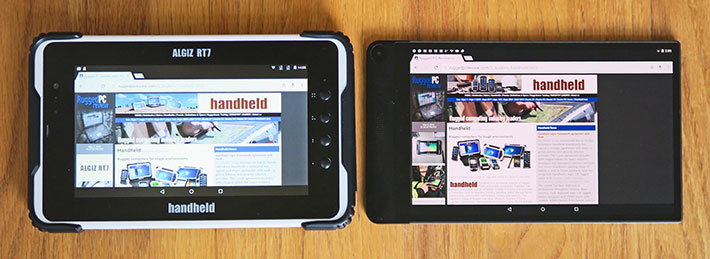
Finally, the Algiz RT7 display has another interesting quality: like a good offroad vehicle, it looks unassuming at first, but then reveals its qualities off the road, and actually gets better and better the more you throw at it. We've rarely seen a rugged tablet display that works so well under so many different outdoor lighting conditions.
Cameras for use on the job
RuggedPCReview.com is on record as having been quite critical of the quality of cameras integrated into rugged computing equipment over the years. While the built-in cameras of modern smartphones and consumer tablets are so good that they have pretty much eliminated the dedicated point & shoot camera market, cameras built into vertical market rugged handhelds have consistently lagged behind. That's most unfortunate as the idea behind adding camera functionality to such devices is to allow their users to document field conditions, findings, reports, etc. Has Handheld given the Algiz RT7 better recording capabilities?
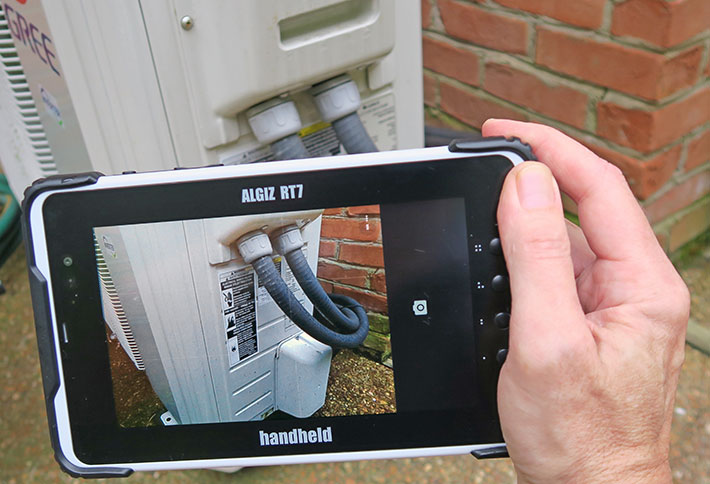
The Algiz RT7's integrated documentation camera can take images with resolutions of up to eight megapixel. It also has an LED illuminator that you can turn on and off via software to add extra light. It's not a flash, but certainly helps taking better close-up pictures.
The Camera app allows shooting in 0.9, 2.1, 3.1, 5 and 8 megapixel stills, and 480p, 720p and full 1920 x 1080 pixel 1080p video. There are three flash settings, you can turn HDR on or off, add a visual grid, do 3 or 10 second timers, and change exposure from -2 to +2. You can also shoot in lens blur, panorama, and photo sphere mode. But that is pretty much it. No extras like scenes, ISO, saturation, sharpness or even white balance. That's pretty minimal. Maybe we overlooked something, as each picture does have a detailed data sheet that includes focal length, aperture, exposure, ISO, geographic coordinates and more.
Things are more elaborate the post-processing area. There, the Gallery app has fairly extensive editing capabilities. The screen snap below shows the camera mode settings screen (left), and some of the editing tools in the Gallery app.

In an era of smartphones with 12, 14 and 16-megapixel cameras that are are starting to be able to record 4k video, extreme slow motion, and do other advanced tricks, the above specs and capabilities remain modest.
However, once we took a number of test pictures with the RT7 camera, we were pleasantly surprised. They were a lot better than what we've seen in the past from mobile computer cameras. Below are some sample shots we took with the RT7 documentation camera. Click on the picture to get a full-size version.
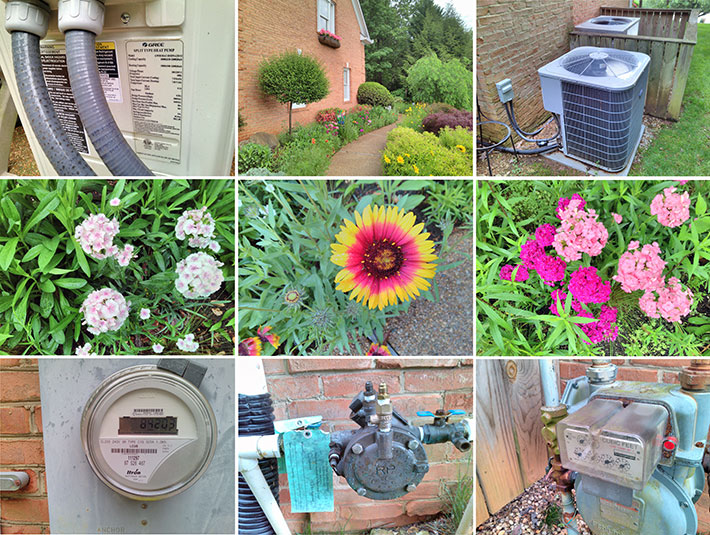
Overall, the Algiz RT7 camera is capable of taking much better pictures than we generally see from industrial handhelds. There is good sharpness and image detail, and little of the massive compression that often renders pictures from such integrated cameras useless. There's also no noticeable lag and the occasional hiccups that often rendered older onboard cameras nearly useless.
Video, likewise, is much improved compared to what we're used to seeing from cameras integrated into rugged devices. Frame rate and focussing are absolutely quick enough to be used on the job. The autofocus is unobtrusive and without the frequent hunting that used to mar such cameras. And the camera never fell behind in our (limited) video testing. The maximum 1920 x 1080 recording format is very useful and sufficient for documentation and other tasks.
The brief video clip to the right was taken with the XT7 camera in 1080p resolution.
Note that the camera applications that come with mobile operating systems are often replaced with third party applications optimized for certain tasks, or developers and systems integrators include camera and video functionality directly into custom applications. Likewise, it's quite possible that downloadable camera apps may provide the missing features.
As is, the still image and video functions of the Algiz RT7 are good enough for many documentation jobs out there in the field.
One tough little tablet
The Handheld Group describes the Algiz RT7 as "perfectly ergonomic, seriously rugged, and ready for any task," and that very much describes this small, compact rugged tablet.
According to its specs, the Algiz RT7 can handle a wide operating temperature range from -4 to 122 degrees Fahrenheit (-20 to 50 Celsius). That's good enough for most deployments, except for extremest heat or cold. It carries IP65 sealing where the "6" means the computer is totally protected from dust, and the "5" that it is protected against low pressure jets of water from all directions. The Algiz RT7 also passed the MIL-STD-810G 516.6. Procedure IV test of 26 drops from a height of four feet to concrete. What does all this mean?

As far as operating temperature goes, the device can be used in most environments where someone would be expected to work with a computer. The folks at the Handheld Group's native Sweden know a thing or two about ice and snow and working in the cold, so we're sure they have low temperature suitability covered, and not having rotating media onboard certainly helps.
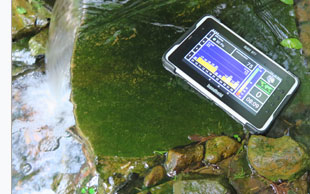 Not having a hard disk also helps make the unit immune to drops from four feet, which is about the height it may fall while being used in a standing position. Here, the Algiz RT7's modest weight (1.425 pounds) and the protective corner bumpers provide excellent shock resistance. Not having a hard disk also helps make the unit immune to drops from four feet, which is about the height it may fall while being used in a standing position. Here, the Algiz RT7's modest weight (1.425 pounds) and the protective corner bumpers provide excellent shock resistance.
IP65 is good sealing, but it's not IP67 which is increasingly expected in rugged outdoor gear, thanks to a growing number of IP67-rated active lifestyle consumer smartphones. So why not IP67, which protects a device even against immersion into water to a depth of about three feet? Probably because it's much more involved to seal a device with multiple standard-size ports and a number of physical buttons to IP67 standard. So IP65 is okay, but there is some concern about potential leaks to the interior when the single protective plug is open due to using even just one of the five ports underneath it. In our field testing, the RT7 had no problem sitting in water or having water run over it.
Vibration resistance was tested as described in MIL-STD-810G, Method 514.6, Procedures I & II, for general vibration in a fixed mounting and a loose cargo test, but there is no detailed description. This would be good to have as many RT7 tablets will likely be mounted and used in vehicles. The Algiz RT7 can handle operating altitudes up to 15,000 feet. This is relevant not only for use in mountainous areas, but also in unpressurized airplanes. The tablet was also tested according to MIL-STD-810G, Method 507.5 for humidity resistance.
While some customers will probably want to see actual lab reports with more specific detail, the overall impression of the Algiz RT7 is that it's indeed a remarkably rugged device that is capable of handling a good deal of abuse.
Summary: Handheld Algiz RT7
The Algiz RT7 tablet carries on the Handheld Group's tradition of offering interesting, versatile mobile computers covering every conceivable part of Handheld's target markets. This tablet is for anyone who needs something light and handy for out there in the field, something that's modern, versatile, tough, ergonomic, and doesn't break the bank.
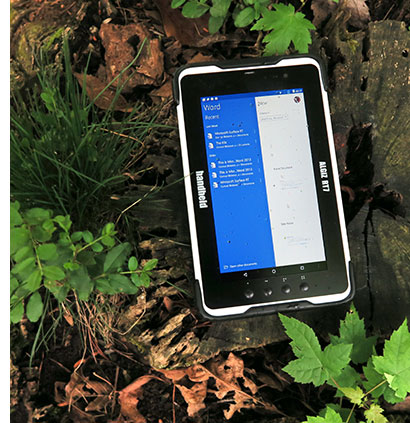 The choice of Android for this tablet makes perfect sense. Android has low resource requirements, is a perfect match for the popular capacitive multi-touch interface, and, thanks to its vast marketshare, has very strong programming and application support. The choice of Android for this tablet makes perfect sense. Android has low resource requirements, is a perfect match for the popular capacitive multi-touch interface, and, thanks to its vast marketshare, has very strong programming and application support.
The very responsive 7-inch daylight-viewable wide-format touch screen display with its 1024 x 600 pixel resolution is well suited for all sorts of field applications. It's bright, handles outdoor reflections very well, and can handle a very wide range of lighting conditions. Some viewing angle-dependent color and contrast variations are the only caveat.
The 1.43 pound Algiz RT7 is rugged enough to be used in almost any environment, and its integrated bumpers protect against dents and scratches. It feels very solid and reliable. All ports are protected by a single well-fitting plug.
The unit provides good onboard communication both for wired connections (USB, USB OTG, LAN, audio) as well as wireless (WiFi, WWAN, Bluetooth, GPS, RFID/NFC). Industrial-grade 1D/2D scanning is available also.
Unlike most specialized vertical market computing equipment, the RT7 is remarkably affordable, providing additional incentive to deploy a tool that was designed from the ground up for work in the field.
In summary, with the new Algiz RT7, Handheld Group offers a sensible, practical Android tablet that's tough enough to go anywhere. The Algiz RT7 skillfully merges consumer tablet technology and feel with the serious features and qualities that matter out there in the field. And it all comes at a price that's right. -- Conrad H. Blickenstorfer, May 2016
Handheld Algiz RT7 Specifications:
| Status |
Added 11/2015, full review 05/2016
|
| Type |
Rugged Android tablet
|
| Processor |
Quad-core Qualcomm MSM8916 |
| Processor speed |
1.20GHz |
| OS |
Android version 5.1.1 (Lollipop) |
| Graphics |
TBA |
| Memory |
1GB LPDDR2 533MHz |
| Display type |
Sunlight-readable 7-inch TFT LCD with chemically strengthened glass, 600 nits |
| Display resolution |
WSVGA 1,024 x 600 pixel
|
| Digitizer/Pens |
Capacitive 5-point multi-touch |
| Keyboard |
On-screen QWERTY soft kbd, soft Android keys, 4 programmable function keys |
| Storage |
16GB eMMC |
| Expansion |
1 x SDHC (up to 32GB), 2 x SIM; optional 2 x SAM |
| Housing |
Plastic with protective rubber bumpers |
| Operating temperature |
-4° to 122° Fahrenheit (-20° to 50° centigrade) |
| Shock |
26 4-feet drops to concrete per MIL-STD-810G Method 516.6, Procedure IV
|
| Vibration |
MIL-STD-810G, Method 514.6 Procedures I
|
| Enclosure Class |
IP65, MIL-STD-810G, IEC 60529 |
| Hazardous materials |
unknown |
| Size |
8.5 x 5.0 x 0.9 inches (216 x 128 x 24 mm) |
| Weight |
1.425 pounds (645 grams) as tested
|
| Power |
3.7V 6,000mAh 22.2 watt-hour Li-Ion battery
|
| Camera |
Front: 2-megapixel; rear: 8-megapixel AF + LED flash
|
| Scanning |
Optional Zebra SE4710 2D barcode reader
|
| Sensors |
3-axis accelerometer, 3-axis gyro, eCompass, proximity & SAR
|
| Interface |
1 x USB 2.0, 1 x micro USB, 1 x RJ45 LAN, 1 x 3.5mm audio in/out, power
|
| Communications |
802.11b/g/n, Class 1 + 2 Bluetooth v4.1, integrated u-blox EVA-7M GPS, 2.5G (GSM, GPRS, EDGE) and 4G LTE; optional 13.56 MHz RFID/NFC
|
| Price |
Starting at US$1,149
|
| Product brochure |
 Algiz 7RT brochure Algiz 7RT brochure |
| Web page |
Handheld Group Algiz RT7 web page |
| Contact |
Handheld Group AB
Kinnegatan 17A
531 33 Lidköping, Sweden
Tel: +46 (0) 510 54 71 70
Fax: +46 (0) 510 282 05
Web: www.handheldgroup.com
Email: info at handheldgroup.com
|
HHCS Handheld USA Inc.
33870 SE Eastgate Circle
Corvallis, OR 97333, USA
Tel: (541) 752-0313
Fax: (541) 752-0338
Web: www.handheld-us.com
Email: info at handheld-us.com
|
|
(copyright 2016 RuggedPCReview.com)
|




 >
>
 Let's answer some obvious questions first. For example, if most of the Nautiz rugged handhelds come with either Windows or Android and the Handheld Group already has a perfectly good 7-inch tablet in the Algiz 7 (the picture on the right shows the Windows-based Algiz 7 and the new Android-based Algiz RT7), why not simply offer that one with Android as well?
Let's answer some obvious questions first. For example, if most of the Nautiz rugged handhelds come with either Windows or Android and the Handheld Group already has a perfectly good 7-inch tablet in the Algiz 7 (the picture on the right shows the Windows-based Algiz 7 and the new Android-based Algiz RT7), why not simply offer that one with Android as well?



 That's because Windows is a much larger and more resource-intensive OS and needs the extra hardware for perceived everyday performance parity. Handheld's Windows and Android 7-inch tablet stablemates follow that same pattern.
That's because Windows is a much larger and more resource-intensive OS and needs the extra hardware for perceived everyday performance parity. Handheld's Windows and Android 7-inch tablet stablemates follow that same pattern.
 The 1.2 GHz Qualcomm MSM8916 "Snapdragon" chip in the Algiz RT7 is indeed a competent quad-core processor with an Andreno 306 GPU that supports all the features that matter in this class of tablet. It's used in numerous Samsung Galaxy, HTC Desire, Asus, Acer, Lenovo, Huawei and Motorola tablets and handhelds.
The 1.2 GHz Qualcomm MSM8916 "Snapdragon" chip in the Algiz RT7 is indeed a competent quad-core processor with an Andreno 306 GPU that supports all the features that matter in this class of tablet. It's used in numerous Samsung Galaxy, HTC Desire, Asus, Acer, Lenovo, Huawei and Motorola tablets and handhelds.
 Onboard memory is just 16GB, but that can be expanded via an SDHC card slot. There's 2.5G (because it's still used in many parts of the world), 3G, as well as 4G LTE (which is state-of-the-art). And there are two SIM slots so both can be supported at the same time.
Onboard memory is just 16GB, but that can be expanded via an SDHC card slot. There's 2.5G (because it's still used in many parts of the world), 3G, as well as 4G LTE (which is state-of-the-art). And there are two SIM slots so both can be supported at the same time.


 A few words here about the ongoing uncertainty of which operating system to go with. As of Spring 2016, we still have the weird situation where Microsoft Windows almost completely rules desktop and notebook computers (with only Apple as a serious general purpose alternative), Android almost completely rules smartphones (again, with only Apple as a serious (albeit mostly high-end) competitor). In tablets, it's all Android on the low end, and almost all Apple on the high end, though Microsoft's Surface tablets are making inroads.
A few words here about the ongoing uncertainty of which operating system to go with. As of Spring 2016, we still have the weird situation where Microsoft Windows almost completely rules desktop and notebook computers (with only Apple as a serious general purpose alternative), Android almost completely rules smartphones (again, with only Apple as a serious (albeit mostly high-end) competitor). In tablets, it's all Android on the low end, and almost all Apple on the high end, though Microsoft's Surface tablets are making inroads.
















 Not having a hard disk also helps make the unit immune to drops from four feet, which is about the height it may fall while being used in a standing position. Here, the Algiz RT7's modest weight (1.425 pounds) and the protective corner bumpers provide excellent shock resistance.
Not having a hard disk also helps make the unit immune to drops from four feet, which is about the height it may fall while being used in a standing position. Here, the Algiz RT7's modest weight (1.425 pounds) and the protective corner bumpers provide excellent shock resistance.
 The choice of Android for this tablet makes perfect sense. Android has low resource requirements, is a perfect match for the popular capacitive multi-touch interface, and, thanks to its vast marketshare, has very strong programming and application support.
The choice of Android for this tablet makes perfect sense. Android has low resource requirements, is a perfect match for the popular capacitive multi-touch interface, and, thanks to its vast marketshare, has very strong programming and application support.
